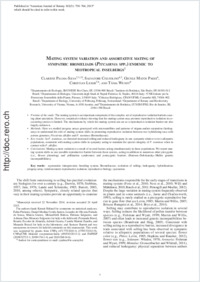Mating system variation and assortative mating of sympatric bromeliads (Pitcairnia spp.) endemic to neotropical inselbergs
- Palma-Silva, Clarisse Departamento de Ecologia, IB/UNESP, Rio Claro, Brazil - Instituto de Botânica, São Paulo, Brazil -
- Cozzolino, Salvatore Dipartimento di Biologia, Università degli Studi di Napoli Federico II, Naples, Italy - CNR Istituto per la Protezione Sostenibile delle Piante, Firenze, Italy
- Paggi, Gecele Matos Ciências Biológicas, CPAN/UFMS, Corumbá-MS, Brazil
- Lexer, Christian Department of Biology, University of Fribourg, Switzerland - Department of Botany and Biodiversity Research, University of Vienna, Austria
- Wendt, Tânia Departamento de Botânica, CCS/IB/UFRJ, Rio de Janeiro, Brazil
-
01.05.2015
Published in:
- American Journal of Botany. - 2015, vol. 102, no. 5, p. 758–764
English
Premise of the study: The mating system is an important component of the complex set of reproductive isolation barriers causing plant speciation. However, empirical evidence showing that the mating system may promote reproductive isolation in co-occurring species is limited. The mechanisms by which the mating system can act as a reproductive isolation barrier are also largely unknown. Methods: Here we studied progeny arrays genotyped with microsatellites and patterns of stigma–anther separation (herkogamy) to understand the role of mating system shifts in promoting reproductive isolation between two hybridizing taxa with porous genomes, Pitcairnia albiflos and P. staminea (Bromeliaceae). Key results: In P. staminea, we detected increased selfing and reduced herkogamy in one sympatric relative to two allopatric populations, consistent with mating system shifts in sympatry acting to maintain the species integrity of P. staminea when in contact with P. albiflos. Conclusions: Mating system variation is a result of several factors acting simultaneously in these populations. We report mating system shifts as one possible reproductive barrier between these species, acting in addition to numerous other prezygotic (i.e., flower phenology and pollination syndromes) and postzygotic barriers (Bateson–Dobzhansky–Muller genetic incompatibilities).
- Faculty
- Faculté des sciences et de médecine
- Department
- Département de Biologie
- Language
-
- English
- Classification
- Biological sciences
- License
-
License undefined
- Identifiers
-
- RERO DOC 257925
- DOI 10.3732/ajb.1400513
- Persistent URL
- https://folia.unifr.ch/unifr/documents/304712
Statistics
Document views: 90
File downloads:
- pdf: 144
